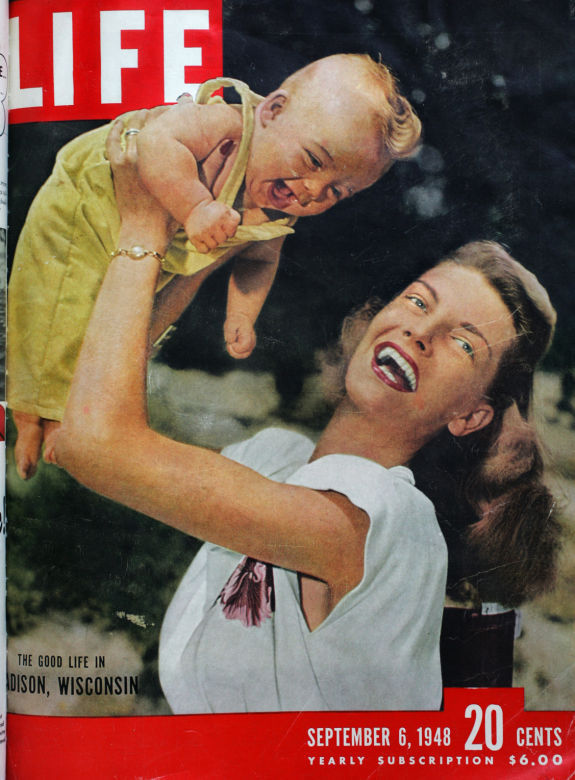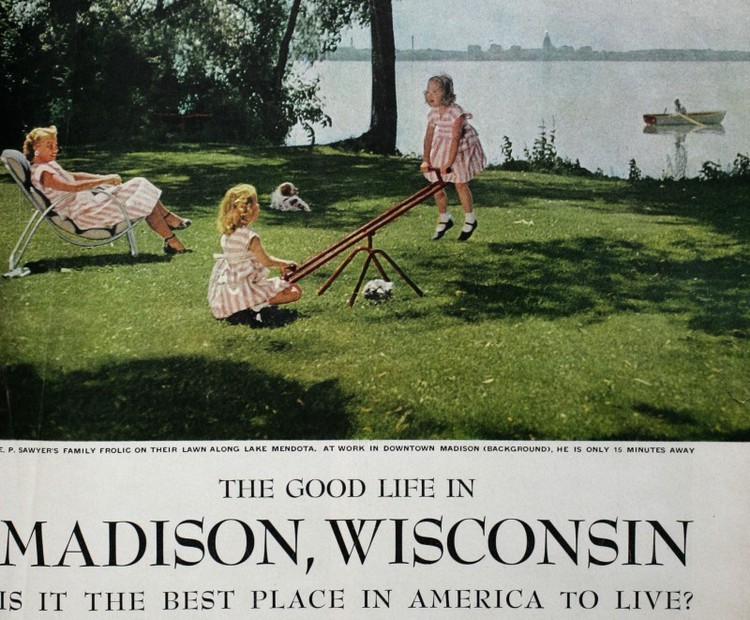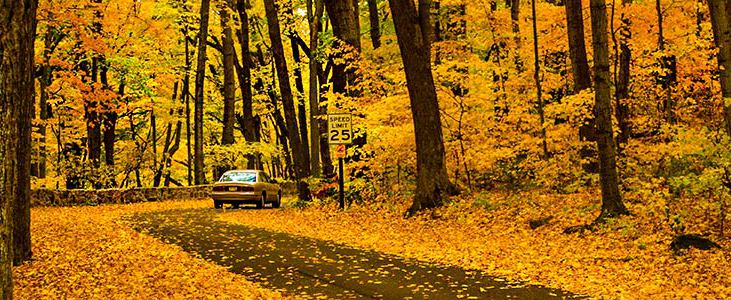



|
After the Ph.D. I moved around, then finally came to Madison for good in 2006, as a professor in the Department of Computer Science at the University of Wisconsin. Since then, with the exception of spending one year in Silicon Valley with a startup, I have been living in Madison. During this time I have grown to appreciate living here. There are multiple reasons for this.
The city is beautiful. Madison's location is
picturesque: a city nestled among
five
lakes, rivers, forests, dairy
farms, and rolling hills. It is very thoughtfully laid out, from way
back in the early 1900s until now. The city is dotted throughout with
numerous postcard-perfect views. Examples include sunset from the
Memorial Union terrace, Picnic Point (any time), lake view from the
Monona Terrace, the 360-degree view from the observation deck of the
State Capitol, the view from Observatory Drive (UW), and many
more. This
set
of pictures is indeed illustrative of Madison's beauty, but is far
from doing justice to it. 
The region is beautiful. The region surrounding Madison (within 1.5 hours of driving) is also very pretty, especially the northwest and the west. Those parts are full of rolling hills, forests, meandering streams, and little savannas. Here and there, you see red barns, silos, little farms, grazing cows. It is the quintessential pastoral scenery. All so pretty and relaxing. There are beautiful state parks within one hour driving, such as Devil's Lake State Park and Governor Dodge State Park, pretty sceneries (such as the dells at Wisconsin Dells), unusual places (such as the House on the Rock), kitschy but fun recreational places (such as Wisconsin Dells), and historical places (such as Taliesin and Lake Geneva) . You can easily find many lists of such places online.
The seasons are stunning. The change of seasons here is dramatic and a feast for the eyes. You will see it in the trees, smell it, and feel it on your skin. The best season is perhaps the fall (mid September to late October). It's a riot of color, in all hues and forms. You can see fantastic fall colors in Madison (the UW arboretum and Wally Bauman Woods are the best) and at Devil's Lake, and it gets even better if you can drive a few hours up north. The winter scenery (early to mid-December, when snow typically falls, until mid March) is beautiful in the UW arboretum and the many wooded parks (especially if you do cross-country hiking). The spring (late March to early May) is again a riot of color, this time from the flowers. Summer is all green forests dotted with lakes and rivers. Check out this page for more detail (and for things to do in each season).
It is more than just skin-deep beauty. Another thing that I really appreciate is that Madison and the surrounding region were the birthplace for several influential figures in the environmental movement, and their influence is still heavily felt today. John Muir, "the father of the US national parks", came from Wisconsin. Aldo Leopold, a former UW professor, was famous for his land ethics, in which he advocated living in harmony with the land, and take care to keep "things natural, wild, and free" (his most famous book, "A Sand County Almanac", is highly influential and a joy to read). Living here, I can feel the influence of Muir and Leopold, and can tell that there is a lot of thoughts coming into building Madison and the region in a way that stays in harmony with the land, the wilderness, and nature. My understanding of the land and its place in our world, as well as an appreciation for nature and the wilderness, grows during my time so far in Madison.
Interesting architectures. Madison is full of neighborhoods with interesting architectures (such as prairie style and mid-century modern houses). There are historic architecture walking tours. Frank Lloyd Wright, a famous American architect, spent considerable time in Madison (and grew up nearby), and you can see multiple houses that he designed in Madison. New apartment complexes being built have generally been designed well (and not too boring). The Epic campus in Verona adds another interesting angle to the architecture landscape in Madison. Check out this house and this house within 10-minute walking distance of my house. Aren't they beautiful and interesting? And of course, Chicago, which is full of architectural history and treasures, is only 3 hours away.
Fantastic outdoor opportunities. This is simply amazing. It is pretty much a given that no matter where you live in Madison, you are only minutes away from numerous outdoor opportunities. For example, within 10 minutes drive from my house (in the Near West), I can kayak on a lake or a river, hike through a forest or a prairie, fish in streams judged to be among the best for trout fishing in the US, or urban hike through an interesting neighborhood. On biking alone, there are miles and miles in many directions. I can hop on a bike trail (2 miles from my house) and bike for hundreds of miles through rolling hills, prairies, and other beautiful sceneries all the way to the Illinois border. There are so many bike trails here (you can also hike or run on them, many of which are open in the winter for snowmobiling). Recently the city put $8M into connecting two bike trails via a bridge across a lake. Rumor has it that they plow the snow on the bike trails before they do that on the roads (I sure hope it's just a rumor). It's no wonder that Madison is consistently ranked as one of the best cities for biking in the US.
And there are outdoor events being organized here year round. For example, you can do the Iron Man here (a friend of mine from UIUC has been here twice doing it). If you are into more exotic stuff, you can bike naked throughout the city (without getting a ticket) to promote a cause (there is an annual event for it, you can find it on YouTube), or go to a cloth-optional beach (25 minutes from Madison on the beautiful Wisconsin River) to swim cloth optionally. People here are also very active outdoor, year round. You will constantly see people bike, run, hike, cross country skiing, and more. Yet places are not crowded. You can easily find solitude, and the necessary peace and quiet to enjoy nature.
This is one of the things I love most about Madison. When I have just a few hours with my family (say at the end of the workday or over the weekend), it takes us no time to be out in the nature and enjoy it. (In contrast, I have lived in cities where it takes 30 minutes just to get to the highway or an hour just to get to a lake or river.)
Numerous interesting events.
 There are many
interesting events year around. Many of them are sport related. I'm
more into the non-sport variety. Here's a sampling of what we do. In
May we go to the UW arboretum to enjoy a brilliant show put on by the
blossoming crab apples and the lilacs. The arboretum has a big
collection of crab apples and has perhaps the largest collection of
lilacs in the world. In June and July it is the prairies' turn to
blossom. In mid August we make sure not to miss the sunflower days at
Pope Farm Conservancy,
where up to 500,000 sun flowers bloom over a vast area of rolling
hills. This view must be seen in person. In September the prairies
again put on an amazing show of fall flowers, with seas of
brilliantly yellow golden rods and dark red tall grasses. (Pheasant Branch
Conservancy and Governor Nelson State Park seem to have the best views.) In mid
October then of course it is hours of hiking in forests and lake banks
in the splendor of the fall color. In December and January we enjoy
the solitude and beauty of a fresh snowfall while hiking (or cross-country skiing) in the UW
arboretum or the many wooded forest parks in and near Madison.
There are many
interesting events year around. Many of them are sport related. I'm
more into the non-sport variety. Here's a sampling of what we do. In
May we go to the UW arboretum to enjoy a brilliant show put on by the
blossoming crab apples and the lilacs. The arboretum has a big
collection of crab apples and has perhaps the largest collection of
lilacs in the world. In June and July it is the prairies' turn to
blossom. In mid August we make sure not to miss the sunflower days at
Pope Farm Conservancy,
where up to 500,000 sun flowers bloom over a vast area of rolling
hills. This view must be seen in person. In September the prairies
again put on an amazing show of fall flowers, with seas of
brilliantly yellow golden rods and dark red tall grasses. (Pheasant Branch
Conservancy and Governor Nelson State Park seem to have the best views.) In mid
October then of course it is hours of hiking in forests and lake banks
in the splendor of the fall color. In December and January we enjoy
the solitude and beauty of a fresh snowfall while hiking (or cross-country skiing) in the UW
arboretum or the many wooded forest parks in and near Madison.
Sometimes we hop on a plane to visit Las Vegas (a suburb of Madison) to escape the cold for a week or so. There we visit the various state and national parks. There are direct flights from Madison to Vegas (under four hours). Sometimes we go to the other suburbs (Florida, Texas, Colorado, Utah, NYC, Washington DC, San Francisco, Los Angeles, Seattle, and more, also with direct flights). We also often go to farmers' markets (the one on the Capitol Square is one of the best markets in the nation and a major tourist attraction).
Strong community sense. There is a strong sense of community in Madison, where people actively participate in community affairs and collectively get things done. The various neighborhoods often organize neighborhood events (such as parties, drives to build up the neighborhood parks). Overall, people here seem very active in community and neighborhood issues. As an example, check out this written-up history of a Madison neighborhood.
High quality services. Madison has good public schools. I have been generally happy with the quality of instructions that my son has received, and with the range of activities being offered. The schools are full of very smart kids (the way schools in a college town usually are). Services such as plumbing, house repair, health care, etc. are generally on time and quite good. This is the first city I have lived in where some plumbers arrived early and then waited in the car to show up on time. Also a few years back the person who fixed my garage door refused to take a tip, saying it was not necessary.
Low-stress living. Life with kids (especially small ones) can be pretty stressful and unpredictable. As such, I really appreciate the fact that Madison is quite low stress in this aspect. Within 2 miles of my house, I have pretty much everything I want: coffee shops, hospitals, schools, Target, grocery stores, haircut places, good restaurants, bars, movie theaters, playgrounds, forests, lakes, hiking trails, etc. From work, I can drive to parent-teacher conferences in 15 minutes, and then be back at work soon after that. A friend remarked that a place like Madison is ideal for raising a family, while perhaps a big city is ideal for retiring once the kids have grown up and flown the nest. There is perhaps some truth in that.
Growing population. "Great for raising a family" is often an euphemism for "too small and not having enough interesting things to do". Madison is not like that. While the city proper has a population of only about 250K, this does not count the contiguous suburbs, such as Middleton, Fitchburg, Verona, etc. Counting them and a few other outlying places, the entire Dane county has a population of 530K. To me this is about the right size: not too small so that I feel that there is nothing to do, but not too large so that the roads are choked with traffic and no matter where I go, it would be crowded. Madison is still growing rapidly though (a lot of people move here from Northern Wisconsin for jobs and good public schools, and from all over the country because many companies here, such as Epic, are hiring). You can see construction cranes everywhere.
Vibrant and growing high-tech scene. As of 2020, I have a startup located in Madison, with significant investment from Informatica, a Silicon Valley company. As a result, I witnessed firt hand three things. First, many national high-tech players want to establish offices in Madison, to recruit talent. In addition to Informatica, we have offices from Google (more than 150 people), Microsoft, Zendesk, Amazon, and more. The list is growing. Second, the local VC presense is also growing rapidly, with a lot of funding for startups. Finally, many local companies, such as American Family Insurance (which invests tens of millions of dollars in a Data Science Institute at UW), Northwestern Mutual, which invests in another Data Science Institute, and Johnson Controls, which has invested in a 100-million VC fund called Wisconn Valley Venture Fund, have also invested big amounts to grow their data science R&D.
Recently, UW has also created a new School of Computer, Data, and Information Sciences, with a lot more funding and a large number of hiring slots, bringing even more high-tech talents to the area.
So it's been a very exciting time to be in Madison if you want to do high-tech stuff. In fact, a recent NYTimes article shows that Madison is the only Midwest city in the top ten of metro areas that have gained the most innovation jobs. For me personally, it has been fun and relatively frictionless. I have access to a large pool of talent from UW, with supportive local high-tech mentoring, plus direct flights to national high-tech hubs such as San Francisco, Seattle, and New York City.
Some other stuff. It would be remiss if I don't discuss several other issues. Madison as a whole is quite progressive and supportive of diversity (granted it is not as racially diverse as many other places). It has a rich cultural life, as seen by the many plays, musicals, symphonies, and other regular artistic performances at the Overture Center for the Arts.
Madison has a vibrant food scene, with many farm-to-table restaurants that many people seem to like. I'm not a foodie, so I can't really comment on this. I am more into the Asian restaurant scene. There, the situation is good in that there are a few good restaurants for each type of food (such as Thai, Chinese, Vietnamese, etc.), but of course nothing approaching the variety, quality, and quantity of a big city, such as Chicago or New York. (Of course, Chicago is only 3 hours away, ideal for a weekend trip.) Beer is good here. Madison has a great number of microbreweries. Enough said.
Winter is a bit longer than at other places (usually lasting from Thanksgivings to mid March, this is the time when the temperature is 15-30 degrees, with an occasional dip into the single digit). See my comment on cold weather. For me, winter has been largely a non-issue because I have a heated garage at home and an underground parking spot at work. Winter is definitely the biggest con that I can think of about living in Madison. But between that and commuting 40 minutes each way (which ends up wasting an hour per day, or five hours per week sitting in the car, compared to my 10-minute commute here), I would gladly take the former.
Flying from Madison is pretty good. It takes about 20 minutes to get to the airport (from my house or the university on the Near West) in light traffic, and 30 minutes in regular to heavy traffic. I usually leave for a domestic flight 1 hour to 75 minutes before the scheduled departure time. The airport is pretty, and going through security is a breeze. As a result, even though I often have to transit at a big city airport (such as Chicago, Denver), my overall flying time is roughly the same compared to flying from a big city (there I would need to arrive at the airport much earlier to avoid traffic jam). The downside is that if a flight is delayed, then things may cascade and I may have more complications (compared to flying from a big city). Madison has direct flights to a whole range of cities (24 as of January 2020), including NYC, Philadelphia, Washington DC, Orlando, Las Vegas, San Francisco, Los Angeles, Seattle, and more (see the complete list).